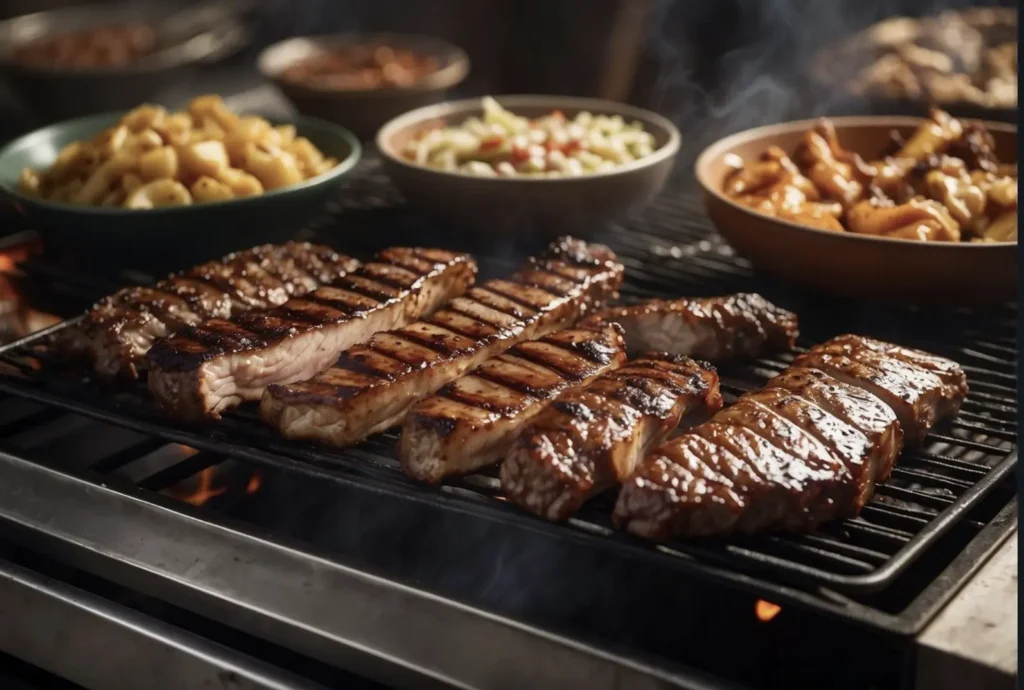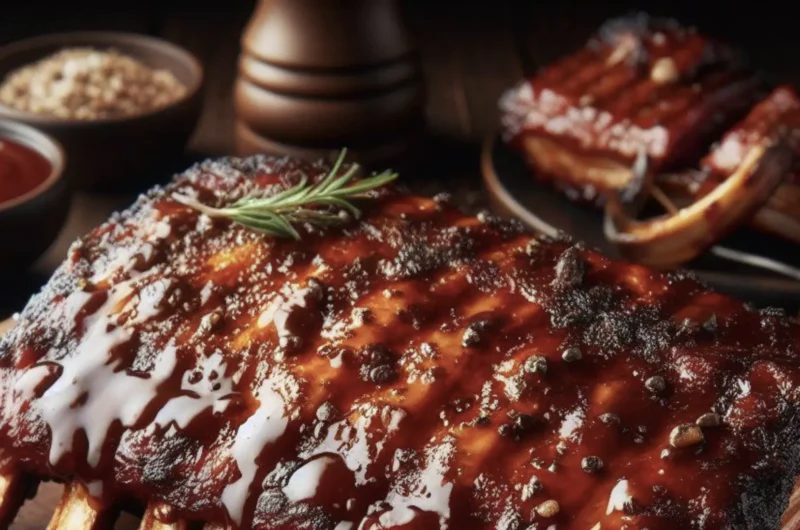When planning a barbecue, one of the most crucial aspects I consider is the quantity of barbecue meat per guest. The aim is to strike the perfect balance to ensure that everyone is satisfied without being wasteful. A good rule of thumb that I follow is to allocate approximately 1/2 pound of meat for each adult attendee and about 1/4 pound for children. This estimate presumes that I’ll also be serving side dishes and that the meal will include more than just pounds of meat.

Understanding the audience is key. If I’m hosting a group of hearty eaters or know that the guests have a particular fondness for barbecue, I might increase the meat portion slightly. The type of meat also influences the amount I serve. For example, when preparing pulled pork, which may reduce in size during cooking, I might plan for a little more than 1/2 pound per person to account for this shrinkage. It’s important to remember that these figures are before cooking; bones and fat will cause some loss of edible meat.
Accurately gauging the appetite and preferences of my guests helps prevent overbuying, which is as critical as ensuring there’s enough food to go around. Attentive forecasting like this aids me not only in providing an enjoyable meal but also in managing costs and reducing waste. With a little experience and careful planning, I can ensure that my barbecue is successful and satisfying for all my guests.
Determining Portion Sizes
In BBQ meal planning, understanding how to calculate correct portion sizes is paramount. It ensures that each of my guests receives an adequate amount of food without resulting in excessive leftovers.
Understanding the Average Needs
For an average adult, the baseline for portion size is typically around 1/3 to 1/2 pound of cooked meat. When I’m hosting a BBQ, I factor approximately 1/3 pound of meat per adult if I’m serving multiple side dishes. In situations where meat is the star attraction with fewer sides, I lean towards 1/2 pound portions.
Adjusting for Appetite Variances
If I’m hosting a larger group, I always consider the demographics of my guests. For example, if the group includes big eaters with larger appetites or if the event spans several hours, I’ll scale up the portions slightly. Conversely, for a group that includes many children or lighter eaters, I may reduce the average portion slightly. Having a variety of side dishes can also influence the amount of meat per person, so I’ll adjust to 1/4 pound if I’m planning for a hearty selection of accompaniments.
Types of Barbecue Meats

In my experience with hosting barbecues, ensuring a diverse selection of meats can cater to various preferences and dietary restrictions. Here’s how I break down the categories:
Beef Selections
When it comes to barbecue, beef is a quintessential choice. I usually consider a half pound of meat as a starting point per person. Notable cuts include:
- Brisket: A staple at any barbecue, brisket is best slow-cooked, with a serving size of about ⅓ to ½ pound per person.
- Steak: From ribeye to sirloin, portion sizes may vary, but typically range around ½ pound per person raw.
Pork Variations
Pork is another popular type of meat for barbecuing because of its rich flavor after being smoked or grilled. Key options include:
- Pulled Pork: For pulled pork, I calculate about ⅓ to ½ pound per person.
- Ribs: Depending on the cut, each guest might enjoy 3 to 4 ribs, which is roughly 0.75 pounds.
Poultry Choices
Chicken and turkey are lighter types of meat that offer a leaner option at a barbecue. They include:
- Chicken: One piece per person is usually sufficient, with a pound of meat often yielding about four servings.
- Turkey: Turkey legs are a hit at barbecues, and each can weigh around half a pound.
Other Meat Options
For more variety of meats, I don’t overlook other options such as:
- Lamb: With its distinct flavor, a pound of meat can serve two to three people.
- Fish and Seafood: Hearty options like salmon steaks require about ¼ to ⅓ pound per person.
Each type of meat requires a different approach to barbecuing, and understanding these distinctions ensures that I offer a well-rounded experience to my guests. There’s a world of choices beyond the conventional beef and pork, allowing for a much bbq delight to suit everyone’s taste.
Calculating Quantities
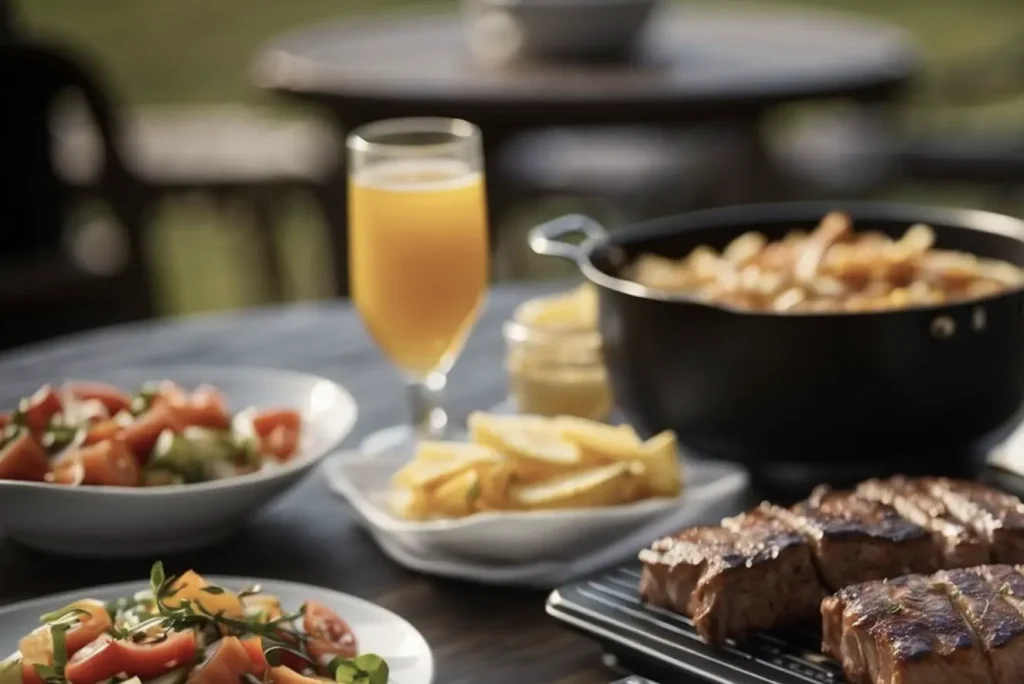
When I’m planning a barbecue, my primary goal is to ensure there’s enough food without excessive waste. Getting the quantities right is a balance of understanding appetite, the type of meat, and cooking processes.
Pounds Per Person
For a satisfying serving, I recommend planning for about 1/2 pound of meat per person. This amount takes into account that some of the weight will be lost during cooking and provides a good rule of thumb to satisfy most appetites.
- Adults: 1/2 pound (8 ounces)
- Children: 1/4 pound (4 ounces)
Adjusting for Meat Type
Different meats have varying levels of richness and fat content, which influences how satisfying they are. For example, fattier meats like pork ribs are more filling, so a smaller serving size might suffice. Leaner meats like chicken breast may require a slightly larger portion to satisfy.
- Rich, fatty meats: slightly less than 1/2 pound
- Lean meats: up to 1/2 pound or more
Accounting for Cooking Loss
Most meats lose about half of their weight during the cooking process, especially when it comes to barbecuing. This is due to water loss and fat rendering. To compensate, I always purchase double the raw weight I anticipate needing based on the serving sizes I’ve calculated.
- Raw weight: 1 pound per person to account for a 1/2 pound cooked serving size
- Cooking loss: about 50% of the meat’s original weight
By following these guidelines, I make sure there’s a good balance of enough food for everyone without going overboard.
Considering Sides
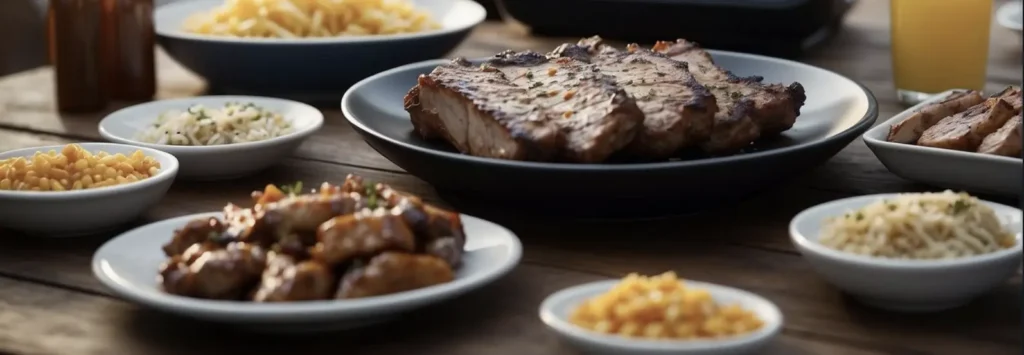
When planning BBQ portions, I always remind people that side dishes will affect how much meat guests eat. Hearty sides like potato salad may fill guests up more quickly, so I could get away with serving less meat per person.
Salads and Vegetables
My go-to salads and vegetables:
- Light salads: Generally, I provide about 1/2 cup per guest as they’re refreshing but not very filling.
- Heavier vegetable dishes: When serving something like a decadent grilled vegetable salad with cheese, I increase this to about 3/4 cup per person.
Starches and Grains
Starches I often include:
- Potato salad: A classic BBQ side, where I allocate roughly 3/4 cup per person.
- Breads and grains: I consider these fillers and serve smaller portions, typically a single slice of bread or 1/2 cup of grains per person.
Event Planning Strategies
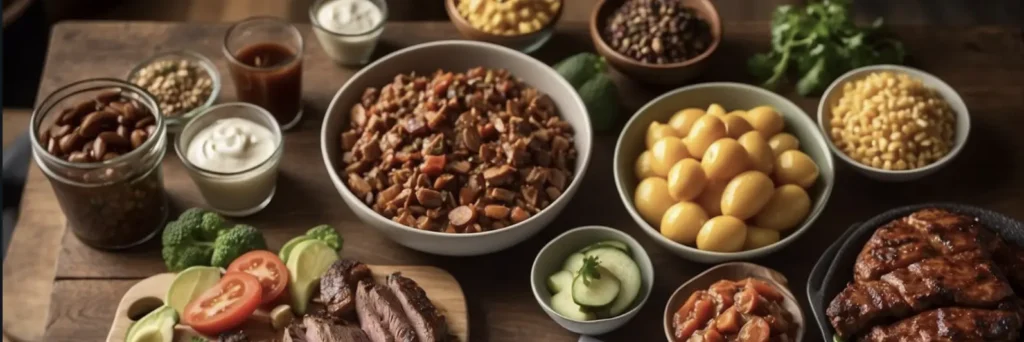
When I plan an event, especially one involving barbecue, I always focus on specific strategies to help ensure just the right amount of food. Here are key considerations I take into account.
Guest List Calibration
For an upcoming event with a large crowd, understanding the exact number of people attending is crucial. I keep my guest list updated constantly to bring clarity to how much barbecue I’ll need. For every adult, I estimate about 8 ounces of cooked meat, and for children, about 4 ounces. These guidelines from professionals offer a good starting point. Here’s a table I often use:
| Adults | Children | Total Meat Required |
|---|---|---|
| 10 | 5 | 100 oz. |
| 20 | 10 | 200 oz. |
| 30 | 15 | 300 oz. |
Adjusting for the exact number of confirmed attendees minimizes waste and ensures everybody leaves satisfied.
Time of Day Considerations
The time of day of my next BBQ affects how much food people will eat. If the event is midday, guests often consume less than in the evening. For a lunchtime barbecue, I trim down meat portions slightly. Here’s how I adjust the servings:
- Lunch (11 AM – 1 PM): reduce each portion by 1 ounce
- Dinner (5 PM onwards): stick to the standard 8 ounces for adults
By considering these two specific elements—calibrating the guest list and adjusting for the time of day—I efficiently plan the meat quantities required for my barbecue-focused events.
Shopping and Preparation Tips
In shopping for a barbecue, I always ensure I have enough meat without the risk of waste, and during preparation, I keep everything safe and properly stored.
Meat Purchasing
When I visit the grocery store, my main goal is to buy the right amount of meat. I aim for around 8 ounces of cooked meat per adult and 4 ounces per child. To be on the safe side and account for cooking shrinkage, I purchase about 12 to 16 ounces of raw meat per adult. I find that an airtight container is essential for storing meat once I get home, especially if I’m not cooking it immediately. This safeguards its freshness and flavor for the barbecue.
Pre-Cooking Preparation
Before starting the cooking process, I prepare my meat by marinating or seasoning it ahead of time to ensure rich flavors. If I’m serving ribs, I count 3 to 4 ribs per person, as bones take up some of the weight. For boneless options, such as pulled pork or brisket, I plan for ⅓ to ½ pound per person. An organized approach ensures that I’m ready for cooking without any last-minute hurdles.
Serving Suggestions
When it comes to ensuring everyone leaves the table satisfied at a barbecue, I know that the amount of meat served is crucial. My goal is to help you prepare just the right amount of meat, with a third of a pound per adult being a good rule of thumb.
Guidelines for Self-Serve
For self-serve situations, where guests are free to fill their own plates, I advise offering a third of a pound of meat per person as a safe bet. This serving size accounts for guests’ varied appetites and the presence of side dishes.
- Pulled Pork: Provide about a third of a pound per person, which is equal to around 5-6 ounces.
- Ribs: Aim for 2 to 3 ribs per person, considering their size and meatiness.
- Brisket/Chicken: Similarly, allocate a third to a half-pound for brisket and one piece of chicken each.
This approach helps avoid the common problem of either running short of food or being left with excessive leftovers.
Plated Portioning
When meals are plated, I find it’s more controlled and I can be precise with the amount of meat served. Here, too, a third of a pound per adult is sufficient, but I can tailor it according to the number of side dishes served and whether it’s a formal or informal gathering.
For Adults:
- Pulled Pork/Brisket: A serving of up to half a pound.
- Chicken: Typically, one piece per person, such as a thigh or breast.
- Ribs: 3 to 4 ribs per person.
For Children:
- All meats: Half the adult serving size is usually enough.
By following these guidelines, I can confidently say that guests will have enough to eat without an excess of waste.
Leftovers and Storage
When it comes to barbecue leftovers from large or family gatherings, my experience tells me that proper storage is key to enjoying your meal for days to come. Being on the safe side, I always ensure leftovers are handled correctly to maintain their quality and safety.
Proper Cooling and Storing
I prioritize swift cooling and transferring to an airtight container for any leftover barbecue. This minimizes the risk of bacterial growth. I follow these steps:
- Allow leftovers to cool to room temperature within two hours.
- Portion the leftovers into small, manageable amounts.
- Place them in airtight containers to prevent moisture loss and contamination.
By following this procedure, I ensure that the quality of the barbecue remains intact and safe for future consumption.
Reheating Recommendations
When it’s time to enjoy the barbecue again, I follow specific reheating recommendations to preserve the flavors and ensure food safety:
- Reheat only the portion I intend to consume, rather than the entire batch of leftovers.
- Use an oven or stovetop for even reheating and to achieve a desirable internal temperature of 165°F.
- Avoid using a microwave if possible, as it can unevenly reheat and alter the texture of the meat.
By reheating my barbecue leftovers with care, I maximize enjoyment while maintaining safety.
Enhancing Your BBQ Experience
To truly elevate your barbecue, consider both the variety of meats offered and how they mesh with your drink selections. This thoughtful approach can significantly improve the culinary journey for your guests.
Diverse Meat Offerings
When planning a BBQ, variety is key. I like to include a range of meats to satisfy different preferences and dietary restrictions. This could include the classic baby back ribs, which are always a hit, alongside options like succulent beef ribs for a hearty choice, or tender and flavorful chicken for those who might prefer a lighter option. Having a mix allows everyone to find something they love, and it turns a simple meal into a feast.
- Baby back ribs – A crowd favorite, perfectly smoked and easy to eat.
- Spare ribs – Larger and meatier, with a delicious fat content that adds flavor.
- Beef ribs – For a robust option, nothing beats the rich taste of beef.
- Chicken – A versatile choice that’s great for smoking or grilling with your favorite BBQ sauce.
Pairing with Drinks
The right beverage can enhance the flavors of your BBQ meats. For wines, a general rule I follow is to pair bold reds with red meat and delicate whites with lighter meats. For instance, a Zinfandel or Syrah complements the smoky flavors of ribs excellently.
Here are some best BBQ wine pairings I recommend:
- Zinfandel – Its fruitiness balances the smokiness of spare ribs.
- Syrah/Shiraz – The spicy notes pair well with the intensity of beef ribs.
Aside from wine, consider serving craft beers or a variety of soft drinks for the non-drinkers. Matching the drinks with the meal is not just a good idea, it’s essential for crafting an unforgettable BBQ experience.
Frequently Asked Questions
When planning a barbecue for any number of people, having a clear understanding of portion sizes and guest preferences is crucial. I’ll walk you through some commonly asked questions regarding the amount of barbecue meat needed per person.
How much BBQ should I plan per guest for a sizable gathering?
For a large gathering, I recommend planning on ½ pound of meat per person. This allows for a satisfying serving for each guest.
What is the average serving size of barbecue for one adult?
An average adult will usually consume between 8 to 12 ounces of raw meat during a barbecue.
How do you calculate the amount of barbecue needed for a group of people?
To calculate the barbecue amount for a group, multiply the number of adults by ½ pound and adjust slightly depending on the group’s age profile and appetite.
What quantity of BBQ is appropriate for a child versus an adult?
While an adult portion ranges from 8 to 12 ounces of raw meat, children typically need about half of that amount.
How do I determine the amount of barbecue required for a large event, such as a wedding or a party?
For such large events, it’s best to stick to the standard of ½ pound per adult whilst considering the total makeup of your guests and the presence of sides. For precise guidance, consult with a catering professional.
How does the type of BBQ (pulled pork, brisket, etc.) affect the amount needed per person?
Different types of barbecue meats can affect portion sizes: for instance, with ribs, you might serve 3 to 4 per person, whereas pulled pork and brisket portions typically range from ⅓ to ½ pound per person.
Baby Back Ribs with Smoky BBQ Sauce
Course: DinnerCuisine: AmericanDifficulty: Easy4
servings10
minutes3
hoursJuicy, fall off the bone baby back ribs with tangy, smoky and sweet homemade bbq sauce will be the hit at your next grilling fest!
Ingredients
2 racks of baby back ribs
1 cup ketchup
1/2 cup apple cider vinegar
1/4 cup brown sugar
2 tablespoons honey
2 tablespoons Worcestershire sauce
1 tablespoon Dijon mustard
1 teaspoon smoked paprika
1 teaspoon garlic powder
1/2 teaspoon black pepper
1/2 teaspoon salt
1/4 teaspoon cayenne pepper (optional for heat)
1 tablespoon liquid smoke (for extra smokiness)
Directions
- Preheat your oven to 275°F (135°C).
- Remove the membrane lining of the ribs on the underside with a sharp knife. Place the ribs on a baking sheet and season with salt and pepper.
- Cover the baking sheet with aluminum foil and bake the ribs for 2-2.5 hours until they are tender.
- While the ribs are baking, prepare the BBQ sauce by combining the ketchup, apple cider vinegar, brown sugar, honey, Worcestershire sauce, Dijon mustard, smoked paprika, garlic powder, black pepper, salt, cayenne pepper, and liquid smoke in a saucepan.
- Simmer the sauce over medium heat for 10-15 minutes, stirring occasionally, until it thickens slightly.
- Once the ribs are tender, remove them from the oven and increase the oven temperature to 425°F (220°C).
- Brush the ribs generously with the homemade BBQ sauce and return them to the oven for 10-15 minutes, or until the sauce is caramelized and sticky.
- Remove the ribs from the oven and let them rest for a few minutes before cutting them into individual portions.
- Serve the ribs with extra BBQ sauce on the side and enjoy!
